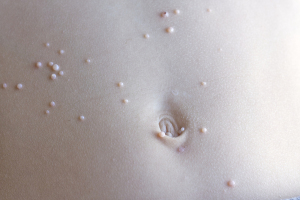Introduction
Molluscum contagiosum warty-like skin lesions of 2 to 8 mm in diameter (about 1/16 inch) are caused by a poxvirus that multiplies in the skin cells and makes them puffed up, thus giving it a protruding, waxy appearance. Here is a picture of molluscum contagiosum.(thanks to www.nlm.nih.gov for this image).
There is a dimple in the center, which can be filled with a whitish material. In children there can be an eczematous skin reaction around a group of these Molluscum contagiosum lesions.
In children it is spread by skin contact when playing with other infected children. As can be seen in this image, the lesions can get super-infected when they are scratched open.
In adults this disease is akin a sexually transmitted disease as skin contact during sex transmits the disease from person to person. In adults the lesions are therefore found mostly in the pubic and genital areas,on the inside of the upper thigh region and in the perianal skin.
Diagnosis and Prognosis
Diagnosis is by inspection and by recognizing the typical dimpled flesh colored, waxy appearance of the lesion. Sometimes the lesions disappear for no apparent reason without treatment. However, most of the time the lesions need to be treated, but tend to respond easier to therapy than warts.
Molluscum Contagiosum Treatment
Treatment with liquid nitrogen is very effective requiring only one or two treatments 7 to 14 days apart. Another treatment modality is trichloroacetic acid (a 25% to 40% strong solution) that is applied to the lesions. This dries up the lesions and they can then be pared down with a surgical blade.
References
1.The Merck Manual, 7th edition, by M. H. Beers et al., Whitehouse Station, N.J., 1999. Chapter 265.
2.James Chin et al., Editors: Control of Communicable Diseases Manual, 17th edition, 2000, American Public Health Association
3.The Merck Manual, 7th edition, by M. H. Beers et al., Whitehouse Station, N.J., 1999. Chapter 112.
4. The Merck Manual, 7th edition, by M. H. Beers et al., Whitehouse Station, N.J., 1999. Chapter 115.
5. The Merck Manual, 7th edition, by M. H. Beers et al., Whitehouse Station, N.J., 1999. Chapter 113.







